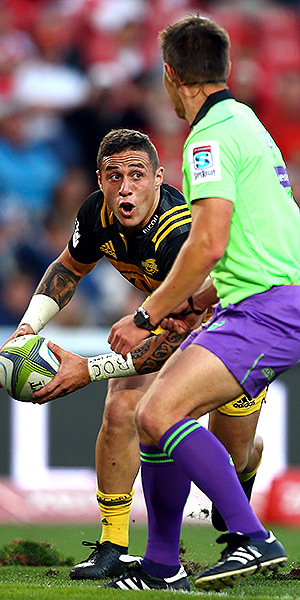Law discussion: The obstructive referee
The Hurricanes have a scrum five metres from the Lions' goal-line. TJ Perenara puts the ball in, the Hurricanes heel and Perenara picks it up at the back of the scrum. He moves forward and then passes to his left, to flyhalf Beauden Barrett who passes inside to Cory Jane who scores under the posts.
The referee, Marius van der Westhuizen, then consults the TMO, asking: "Did the player still have the ball when he ran into me?"
The player in this case is Perenara who had possession of the ball. The reason for the question is that Faf de Klerk, the Lions' scrumhalf, in trying to get to Perenara had run into the referee who was between De Klerk and Perenara.
The referee and the TMO agree that Perenara had passed the ball before he made contact with the referee. Because of that the referee awards the try to the Hurricanes, scored by Jane.
At half-time a commentators reviewing the half, clearly felt that the Lions had had a raw deal and one of the instances he brings up is this. He talks about "the obstruction when the ref gets in the way of Faf when he's trying to tackle Perenara. The ref didn't think that he would have reached Perenara. But that wasn't the point. The point is that Faf may have been able to tackle the inside man.
"If the ref gets in the way of a player, just blow the whistle and have a scrum."
He described this as a "bad decision".
The referee is not a law-maker. He is a servant of the law, his sole job being to serve the law in a match by applying the laws made by the body responsible for making the law, namely World Rugby which was previously known as the International Rugby Board.
The referee is not entitled to act on his own whims or feelings. In this case the referee may have felt for the Lions because he came between Faf and Perenara – not deliberately but by the accident of his position on the field at that time.
The question he asks the TMO is exactly the right one: "Did the player [Perenara] still have the ball when he ran into me?"
Let's look at the law which has been in this form, since 1958.
Law 6.A.10 THE BALL TOUCHING THE REFEREE
(a) If the ball or the ball-carrier touches the referee and neither team gains an advantage, play continues. If either team gains an advantage in the field of play, the referee orders a scrum and the team that last played the ball has the throw-in.
This cuts out Faf de Klerk's contact with the referee as he was neither the ball nor the ball-carrier.
But Perenara was a ball-carrier. The point of the referee's question is relevant.
If Perenara had the ball when he made contact with the referee, the referee could then assess whether the Hurricanes got advantage form Perenara's contact with the referee.
But the referee and the TMO agreed that Perenara did not have the ball when he made contact with the referee.
That means that when he made contact with the referee, he was not a ball-carrier.
There is nothing in the law that makes provision for a situation where a player who does not have the ball makes contact with the referee – unless he is doing something wrong in doing so.
The idea of 'blowing the whistle and having a scrum whenever the referee gets in the way of a player is a recipe for chaos!
The referee's action in this case was correct and his question a wise one.
By Paul Dobson
@rugby365com


















































